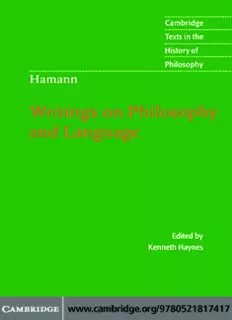Table Of ContentCAMBRIDGE TEXTS IN THE
HISTORY OF PHILOSOPHY
JOHANN GEORG HAMANN
Writings on Philosophy and Language
CAMBRIDGE TEXTS IN THE
HISTORY OF PHILOSOPHY
Serieseditors
KARL AMERIKS
ProfessorofPhilosophy,UniversityofNotreDame
DESMOND M. CLARKE
ProfessorofPhilosophy,UniversityCollegeCork
ThemainobjectiveofCambridgeTextsintheHistoryofPhilosophyistoexpandtherange,
varietyandqualityoftextsinthehistoryofphilosophywhichareavailableinEnglish.
Theseriesincludestextsbyfamiliarnames(suchasDescartesandKant)andalsobyless
well-knownauthors.Whereverpossible,textsarepublishedincompleteandunabridged
form,andtranslationsarespeciallycommissionedfortheseries.Eachvolumecontainsa
criticalintroductiontogetherwithaguidetofurtherreadingandanynecessaryglossaries
andtextualapparatus.Thevolumesaredesignedforstudentuseatundergraduateand
postgraduatelevelandwillbeofinterestnotonlytostudentsofphilosophy,butalsotoa
wideraudienceofreadersinthehistoryofscience,thehistoryoftheologyandthehistory
ofideas.
Foralistoftitlespublishedintheseries,pleaseseeendofbook.
JOHANN GEORG HAMANN
Writings on Philosophy
and Language
TRANSLATED AND EDITED BY
KENNETH HAYNES
BrownUniversity
CAMBRIDGEUNIVERSITYPRESS
Cambridge, New York, Melbourne, Madrid, Cape Town, Singapore, São Paulo
Cambridge University Press
The Edinburgh Building, Cambridge CB28RU, UK
Published in the United States of America by Cambridge University Press, New York
www.cambridge.org
Information on this title: www.cambridge.org/9780521817417
© Cambridge University Press 2007
This publication is in copyright. Subject to statutory exception and to the provision of
relevant collective licensing agreements, no reproduction of any part may take place
without the written permission of Cambridge University Press.
First published in print format 2007
ISBN-13 978-0-511-34192-2 eBook (MyiLibrary)
ISBN-10 0-511-34192-X eBook (MyiLibrary)
ISBN-13 978-0-521-81741-7 hardback
ISBN-10 0-521-81741-2 hardback
Cambridge University Press has no responsibility for the persistence or accuracy of urls
for external or third-party internet websites referred to in this publication, and does not
guarantee that any content on such websites is, or will remain, accurate or appropriate.
Contents
Introduction pagex
Chronology xxix
Furtherreading xxxii
Noteonthetext,translation,andannotation xxxvi
Twodedications,fromSocraticMemorabilia()
EssayonanAcademicQuestion()
MiscellaneousNotesonWordOrderintheFrench
Language()
CloverleafofHellenisticLetters()
AestheticainNuce()
TheLastWillandTestamentoftheKnightofthe
Rose-Cross()
PhilologicalIdeasandDoubts(writtenin)
TotheSolomonofPrussia(writtenin)
NewApologyoftheLetterh()
GolgothaandSheblimini!()
v
Contents
MetacritiqueonthePurismofReason(writtenin)
FromDisrobingandTransfiguration:AFlyingLettertoNobody,
theWellKnown()
Indexofbiblicalpassages
Indexofnames
vi
Introduction
Johann Georg Hamann (–) is prominent in the history of Ger-
manliterature,beingknownaboveallforanidiosyncraticandsometimes
bizarrestylethatwasintransigentlyatoddswiththeaestheticsofhistime
andwhichfascinatedandsometimesinfluencedwritersofthenineteenth
century.HeisoneofthemostinnovativefigureswithinLutherantheol-
ogyandarguably“themostprofoundChristianthinkeroftheeighteenth
century”; hisinsistenceonthehistoricaltruthoftheBibleledhimtoa
radical rethinking of the nature of both history and truth. Finally, he is
aphilosopherwhowrotepenetratingcriticismsofHerder,Jacobi,Kant,
andMendelssohn;whogavephilosophicalattentiontolanguageinaway
that, at times, seems strikingly modern; but whose own philosophical
positionsandargumentsremainelusive.
Hamann was a minor civil servant for most of his adult life, working
inKo¨nigsbergaspartofthewidelyhatedtaxadministrationofFrederick
theGreat.Heneverattainedanysortofsignificantprofessionalsuccess;
friends had to intervene to prevent the sale of his library and to fund
theeducationofhischildren.Ontheotherhand,hehadthefreedomof
his failure inasmuch as he was not obliged to meet the expectations of
anyparticularaudience.Heexercisedhisfreedominseveralrespects:to
developarebarbativeandenigmaticstyle,torejectbasicassumptionsof
hiscontemporaries,andtorangefreelyacrossdisciplines.
Hamann,however,wasnotmerelymovingacrossdisciplinesbutfind-
ing his deepest themes reiterated in a variety of material: ancient and
Hendrik Kraemer, as quoted by James C. O’Flaherty, “Some Major Emphases of Hamann’s
Theology,”HarvardTheologicalReview:(January),.
vii
Introduction
contemporary; sacred and secular; historical, political, economic, theo-
logical,literary,andjournalistic;andinawiderangeoflanguages.Some
ofhismostprofoundwritingwascomposedattheintersectionofphilol-
ogy, theology, and philosophy. Often he has been considered from only
one of those perspectives, which is not only inadequate but also ironic
insofarashisownemphasiswasonunity.Thepowerfulcriticismwhich
Hamannmadeinoppositiontohisagewasatoncestylistic,theological,
andphilosophical.
Hamannandliterarystyle
Hamann formed his style after experiencing a religious crisis. In ,
while working for a firm run by the family of a friend, he went on a
businesstriptoEngland,wherehewasnotsuccessful,eitherprofession-
ally or personally. After some months he began to despair of the life
he was leading; this led to a religious crisis in which he recovered and
radicalized the Christian faith of his childhood. When he returned to
Ko¨nigsberg, his friends Kant and Johann Christoph Berens sought to
redirect him toward his previous, more secular and Enlightened, orien-
tation, suggesting that he translate articles from the Encyclope´die. After
an initial effort, Hamann gave up and began his own writing career in
earnest.ThestylehecultivatedwastheoppositeofthatoftheEncyclope´die,
obscure rather than perspicuous, personal and even private rather than
disembodiedandanonymous,eruditeandsometimesobsceneratherthan
politeandcomplaisant.Thestylewasareproachtothelanguageusedby
Enlightenmentwriters;itwasacritiqueoftheirlanguagebymeansofhis
language.
For example, the first dedication of Socratic Memorabilia () is
addressed to the “public,” but it is far from ingratiating itself with a
potential audience; rather, it presents the public as a phantom and an
idol,afraudperpetuatedbytheculturedeliteandnodifferentfromthe
fraudattemptedbytheprophetsofBaalorthepriestsofBel.Throughout
his career, Hamann had an extraordinary sensitivity to the keywords of
his age – like “public” – which he found evasive, obsequious, and self-
contradictory. The word “public” seems to imply the existence of such
an entity, but who is the public, and how do the many voices of people
becomethesinglevoiceofthepublic?Afterparodyingaflatteringappeal
viii
Introduction
tothisputativepublic, whichconcludeswithascatologicalclassicalallu-
sion, Hamann adds a second dedication to two friends. From this book
onwards,hisstylemakesuseofparody,localreferents,biblicalquotations,
obscenity, and wide-ranging allusions. The style is not polite; Hamann
writesthatitisnotmadefortaste.
Hamann’sparodyismotivatedbyadesiretorefuseclaimsimplicitin
otherwaysofwriting.Heisneverhappierthanwhenusingittoshow,or
imply, that a reasonable position set out in a reasonable style is actually
a fanatical and mystical one – where all three adjectives, “reasonable,”
“fanatical,”and“mystical,”werestronglychargedkeywordsofthetime.
InthededicationtoSocraticMemorabilia,faithinapublicisequatedto
faith in Baal. When Hamann began, in the last part of his life, to write
aboutphilosophicaltextsdirectly,heappliedananalogousskepticismto
philosophicalterms.Theterm“metaphysics,”forexample,isalinguistic
accidentthathasinfectedthewholestudy. Aprepositionwhichshould
indicate, empirically and spatially, the standard position within his cor-
pus of one book of Aristotle’s relative to his Physics has come to mean,
abstractly and transcendentally, that something goes “beyond” physics
andissometimesallegedtosecurethevalidmeaningofthemerelyphys-
ical.ForHamannthis“beyond,”likethe“public,”hasbecomeanobject
ofsuperstitiousvenerationdisguisedasreasonableness.
Kant, for example, in the Critique of Pure Reason, refers to a “tran-
scendental object,” which he glosses as “a something = , of which we
know,andwiththepresentconstitutionofourunderstandingcanknow,
nothingwhatsoever.”InhisMetacritiqueonthePurismofReason(),
Hamann responds to Kant’s claim by presenting this equation as every
bitasmysticalandsuperstitiousasthescholasticphilosophycondemned
bythephilosopheHelve´tius(seep.below):
Moresophisticateddiscussionsofpublicdiscoursehadtowaittwentyyears;seetheessaysbyKlein,
Bahrdt,Moser,andFichteonthepublicuseofreasoncollectedinJamesSchmidt,ed.,Whatis
Enlightenment?:Eighteenth-CenturyAnswersandTwentieth-CenturyQuestions(Berkeley,CA,),
aswellasthemorefamousessaysbyKant(onwhichseeespeciallyOnoraO’Neill,“ThePublic
UseofReason,”ConstructionsofReason(Cambridge,),–).Parodiesofdedicationstothe
publiccontinuedintothenineteenthcentury;cf.thededicationtoE.T.A.Hoffmann’sLifeand
OpinionsoftheTomcatMurr().
“Thehereditarydefectandleprosyofambiguityadherestotheveryname‘metaphysics’...the
birthmarkofitsnamespreadsfromitsbrowtothebowelsofthewholescience”(p.).
ix
Description:Johann Georg Hamann (1730-1788) is a major figure not only in German philosophy but also in literature and religious history. In his own time he wrote penetrating criticisms of Herder, Kant, Mendelssohn, and other Enlightenment thinkers; after his death he was an important figure for Goethe, Hegel,

